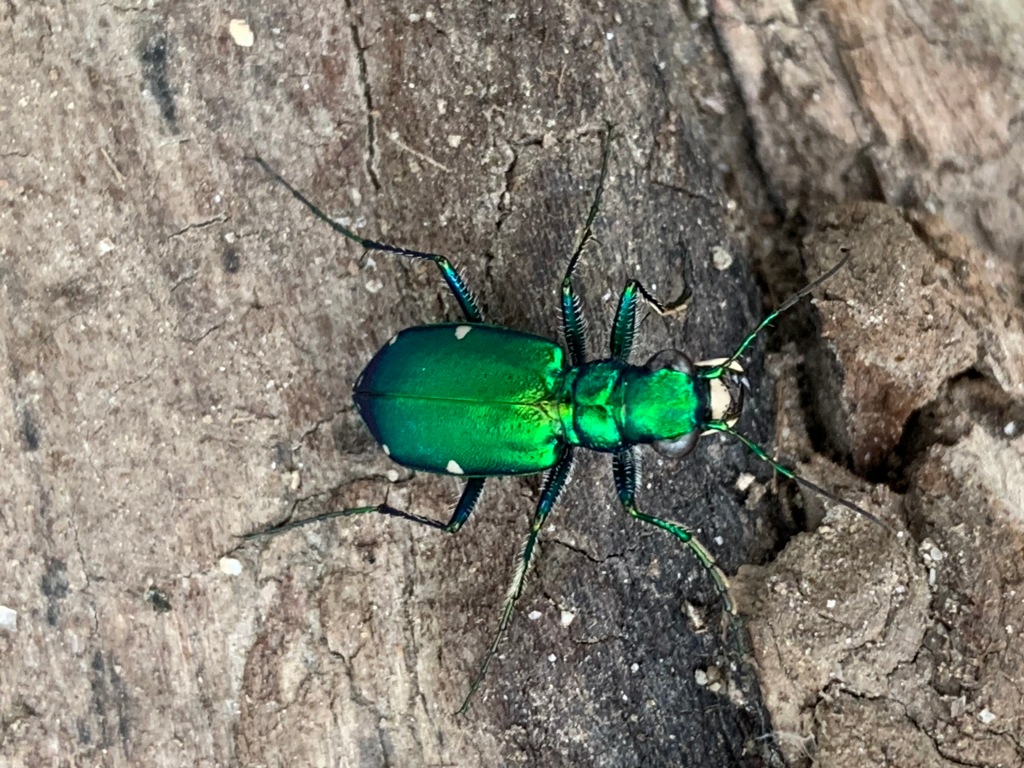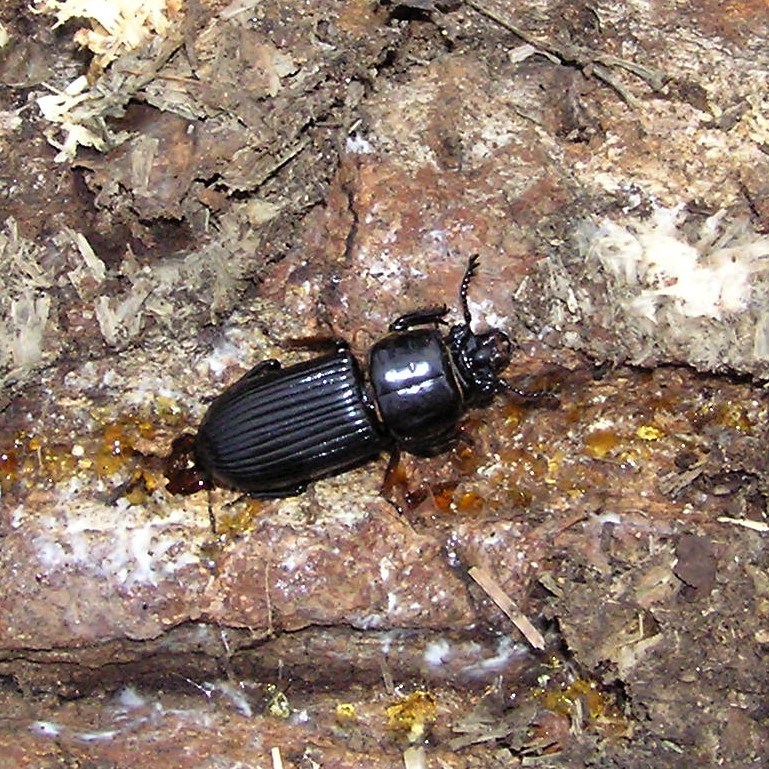
Common Name: Six-Spotted Green Tiger Beetle – It is evident on inspection that the tiger analogue has nothing to do with physical appearance. The yellow and black stripes of the tiger are only one of its signature characteristics … the other is consummate predator. Tiger beetles are similarly noted for their ability to chase down prey with tiger-like ferocity on a smaller scale. The tiger beetle of eastern North America is bright green with as many as six white spots around the periphery of the carapace, though the number can vary and some lack spots altogether.
Scientific Name: Cincindela sexguttata – The iridescent metallic shine of the carapace is captured in the genus name, as Cincindela means “glow-worm” in Latin. Guttae means spots or marks on animals, so the species name meaning “six little spots” is a direct translation, as sex is six linguistically.
Potpourri: The order Coleoptera is the largest in the animal kingdom; one of every three insects is a beetle. There are over 300,000 species worldwide with one tenth of that number in North America, including the ladybugs that eat aphids, the American carrion beetles that consume carcasses, and the tumble bug that buries dung balls for use as larval food. Beetles comprise a menagerie in form, fit, and function that has filled every niche possible in the tangled web of life, the original Beatlemania. Their most notable trait is the dorsal covers called elytra that provide armored protection to the wings, encasing the delicate, diaphanous membranes to avert tearing damage. The robust aerial mobility thus sustained adds to a substantive set of survival traits. Completely metamorphosing through egg, larva and pupal stages to adult, beetles are mostly predacious, eating whatever they can find. [1] Coleopterans are ancient, dating from the end of the Permian about 300 million years ago with the emergence of gymnosperm plants that were likely their original niche habitat ― the pine bark beetles decimating the western North American conifer forests are among their successful successors. [2] The robustness of the beetle form and function is evident in their persistence across eons of time. An analysis of over 5,000 beetle fossils from 200 sites revealed that there have been 214 different families since their first appearance and that 179 are still in existence … some of the original families have persisted throughout. [3] Tiger beetle fossils date from only the Cretaceous, about 140 million years ago, and are, as such, one of the more recent types; there are now 2300 species globally. [4] Beetles are one of nature’s more “intelligent” designs.
Tiger beetles are sometimes considered a subfamily of Carabidae, the ground beetles. They are both in the suborder Adephaga, which means “voracious” in Greek, a nomenclature accounting for their status as apex predators of leaf litter and rotting wood. The distinction between ground and tiger beetles is a matter of habitat and behavior. Ground beetles are primarily nocturnal hunters, spending their daylight hours hidden under rocks or burrowed into logs where they are frequently found in scurrying hordes. They are mostly dark brown or black as a matter of crypsis, blending into the dark colors of forest detritus. It is hypothesized that the wing covers or elytra that characterize the beetles evolved as a protective measure for living under bark. This is supported by the relative simplicity of the carabids with flat, oval bodies having a smooth surface and moderately long antennae and appendages, suggesting that they were among the earliest beetle forms.

The tiger beetle is the yang to the ground beetle yin, barreling across the trail in broad daylight with a Times Square neon flash. Their most noteworthy characteristic is speed which is important both in pursuit of prey and in escape from predation. The standard stratagem is standing stock still at a location affording some visibility of an open area, like a trail. The sight of a moving object that could be food instigates a Gadarene sprint to intercept and attack. Likewise, a looming shadow, such as that cast by a passing hiker, triggers the same frenetic response, only this time to escape in the leaf litter. They are frequently seen bolting across the trail to the nearest hiding place, the bright green streak is hard to miss. Just as the ground beetles live in drab-colored obscurity, the tiger beetles scintillate with a metallic sheen. The effect is similar to a liquid crystal in reflecting polarized, aligned light when subjected to unpolarized, random light of the sun’s rays. This is achieved with a complex layering of the exoskeleton with alternating five, six, or seven sided cells that could hardly be random.[5] But what is the purpose of green and flashy? Bright colors are easier for predators to spot just as they are easier for intended prey to avoid. Evolution would not favor a mutation that made hunting (and nutrition) more difficult nor one where being eaten becomes more likely. The bright color trait has been retained through evolutionary generation, however, so it must promote survival rather than hinder it regardless of how illogical that seems. It likely has something to do with species identification for mate selection, as there are literally thousands of beetles to choose from.
Two aspects of the bounding beetle are immediately apparent: high speed and abrupt stops. The hinged joints for which the arthropods are named are epitomized in the six long legs of tiger beetles. They can move at over half a meter per second, which is about one mile per hour. While this does not approach absolute world record time, relativity is relevant. The body length of a tiger beetle is about ten millimeters which means that it is moving at the rate of fifty body lengths per second ― this would equate if scaled up to ten times the speed of a world class human sprinter. The fastest known tiger beetle is Cincindela hudsoni which is indigenous to Australia … it can move at 2.5 meters per second, outrunning a similar sized cheetah. The alternating stop-and-go staccato foot race is also a result of high speed. The tiger beetle is literally going too fast to maintain an adequate visual input for sensory continuity and must therefore stop to reconnoiter from time to time, mostly to vector toward its intended unwitting prey. [6] There is an obvious problem with this scenario. If it can’t see, how does it avoid obstacles that must surely lie along a random path? Like sight-impaired people negotiating movement with the help of a white probe, tiger beetles hold their antennae rigidly just off the ground as mechanical sensors. Experimentally, it has been demonstrated that blinded tiger beetles can avoid a barrier placed in their path but that those with shortened antennae run headlong into it. [7]
From the perspective of arthropods, beetles lead a full life that usually starts with sex. The male reproductive organ known as the aedeagus (from Greek ta aidoia meaning “the genitals”), is inserted into the bursa copulatrix (something like copulating purse) of the female who stores the sperm in the saclike spermatheca until the time is right. With all of the indistinguishable beetles scurrying about in the duff, how is it that a male of one species successfully mates with a female of the same species? This same conundrum faced the French entomologist René Jeannel in his study of the thousands of nearly identical cave beetles in the Mediterranean Basin. After a lifetime of spelunking and dissecting, he revealed one of nature’s strange but true secrets: the shape of the aedeagus was different for each separate species of cave beetle, an observation he revealed in his 1955 memoir L’édéage (which is the French spelling). Since then, field research has revealed that this is the rule and not the exception concerning animal procreative anatomy. In some cases, such as the 35 species of North American bumblebee, this is the only reliable taxonomy tool. There is some speculation as to why this is so. The obvious “lock-and-key” theory that comes readily to mind when considering accesses of his kind may not be correct. A more nuanced sexual stimulation purpose is gaining ground … that the joy of sex extends to the lower branches of the tree of life, and even into ground around it. [8]
Assuming that a male beetle finds a like-minded mate, which we now know is constrained by other factors of which venery (sexual indulgence) may be involved, the female lays eggs on or near a food supply and they hatch into larvae. Tiger beetle larvae learn the other form of venery (hunting) early in life. It is a pity that a word as rich in meaning as venery has become archaic, which is only the case due to lack of use … a good reason to use it. Insect larvae are for the most part pulpy and worm-like with no defense save toxicity against predators. Feeding mostly on vegetation, they can lay waste to an entire crop in their relentless, rapid, and continuous growth, pausing only for pupation to the adult stage. Tiger beetle larvae are bushwhacking carnivores, a harbinger of the adult predators that they will become. Bare sand or open ground habitat is chosen by adult females as an egg repository to suit the larval smorgasbord consisting mostly of ants and small flies. After digging a burrow with their large jaws, the larvae back into the hole and anchor themselves with rigid hooks, their considerable maw now positioned in the ambush mode. The passage of a hapless wayfarer triggers the lunging larval jaw at the end of its anchored body that clamps down in less than an eye blink’s time (much less actually, as an eye blink takes a tenth of a second and the larva takes a hundredth). A successful strike yields a protein meal, which is masticated to the liquid state with regurgitated digestive fluids. The insect juice is then consumed, the larger chunks filtered by hairs called setae on the labium/lip, a spider-like cuisine retained in adulthood. [9] Life in the soil is nasty, brutish, and short, just like war-torn human society as Thomas Hobbes observed in Leviathan.
Tiger beetles and their closely related (and sometimes conflated) carabid cousin ground beetles are benign from the anthropocentric perspective, other animals like other insects probably deem them less likable. They are generally significant vectors for pest control (a “pest” being defined by humans as any animal that eats anything agriculturally grown) particularly against the sap-sucking aphids that can devastate cereal crops and sugar beets, and even their fellow (not so benign) coleopterans like weevils. Field studies aimed at improving biological controls as substitutes for sometimes harmful chemical pesticides have found that agricultural practices like deep plowing are inimical to carabid/tiger populations [10]. Given the great diversity of the carabids ― there are 40 thousand species world-wide and two thousand in North America, there remains much that is unknown concerning their feeding habits. In laboratory testing on those species that have been subject to investigation, they will eat almost anything proffered, including slugs and moth caterpillars. It is generally agreed that the presence of a significant population of “good” beetles can reduce crop damage by up to 40 percent. There are at least a number of notable species that eat weed seeds, suggesting a possible alternative to herbicides, the most expensive component of pest control at $27 billion annually. [11] So the next time you are hiking and see a flash of green, pick your next step carefully as a tiger may await. And the next time you turn over a log and surprise a beetle congregation, put it back, they may be saying grace.
References:
1. Milne, L. and M. National Audubon Society Field Guide to North American Insects and Spiders, Alfred A. Knopf, New York, 1980, pp 533-540.
2. Gressitt, J. “Coleoptera” Encyclopedia Britannica, Macropedia, William Benton, University of Chicago, 1974, Volume 4, pp 828-837.
3. Perkins, S. “Beetles almost never go extinct” Science, 17 March 2015.
5. “Bright Shiny Beetles” Science, 24 July 2009, Volume 325, Issue 5939 p 366
6. https://news.cornell.edu/stories/1998/01/tiger-beetles-go-blind-chasing-prey-high-speeds
7. https://www.sciencedaily.com/releases/2014/02/140211113704.htm
8. Schilthuizen, M. Nature’s Nether Regions, Viking Penguin, New York, 2014, pp 28-64.
9. Marshall, S. Insects, Their Natural History and Diversity, Firefly Books, Buffalo, New York, 2006, pp 258-261.
10. Kromp B. (1999). “Carabid beetles in sustainable agriculture: a review on pest control efficacy, cultivation aspects and enhancement” Agriculture, Ecosystems and Environment. June 1999 Volume 74 Issues 1–3 pp 187–228.

Best yet.Loved the humor. Learned a lot. Larry
LikeLike